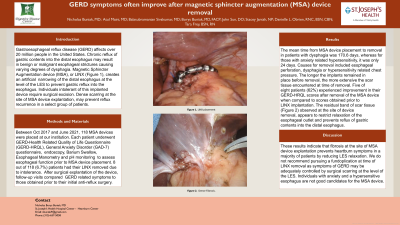Back


Poster Session C - Monday Afternoon
Category: Esophagus
C0204 - GERD Symptoms Often Improve After Magnetic Sphincter Augmentation (MSA) Device Removal
Monday, October 24, 2022
3:00 PM – 5:00 PM ET
Location: Crown Ballroom

Has Audio

Nicholas B. Buniak, MD
Heartburn Center at Saint Joseph's Hospital Health Center
Liverpool, NY
Presenting Author(s)
Nicholas Buniak, MD, Atul Maini, MD, Balasubramanian Sivakumar, MD, Borys Buniak, MD, John Sun, DO, Stacey Jantsch, NP, Danielle Obrien, RNC, BSN, CBN, Tara Frey, BSN, RN
Heartburn Center at Saint Joseph's Hospital Health Center, Syracuse, NY
Introduction: Gastroesophageal reflux disease (GERD) affects over 20 million people in the United States. Chronic reflux of gastric contents into the distal esophagus may result in benign or malignant esophageal strictures causing varying degrees of dysphagia. Magnetic Sphincter Augmentation device (MSA), or LINX, creates an artificial narrowing of the distal esophagus at the level of the LES to prevent gastric reflux into the esophagus. Individuals intolerant of this implanted device require surgical excision. Dense scarring at the site of MSA device explantation, may prevent reflux recurrence in a select group of patients.
Methods: Between Oct 2017 and June 2021, 118 MSA devices were placed at our institution. Each patient underwent GERD-Health Related Quality of Life Questionnaire (GERD-HRQL), General Anxiety Disorder (GAD-7) questionnaire, endoscopy, Barium Swallow, Esophageal Manometry and pH monitoring to assess esophageal function prior to MSA device placement. . 8 out of 118 (6.7%) patients had their LINX removed due to intolerance. After surgical explantation of the device, follow-up visits compared GERD related symptoms to those obtained prior to their initial anti-reflux surgery.
Results: The mean time from MSA device placement to removal in patients with dysphagia was 170.6 days, whereas for those with anxiety related hypersensitivity, it was only 24 days. Causes for removal included esophageal perforation, dysphagia or hypersensitivity related chest pressure. The longer the implants remained in place before removal, the more extensive the scar tissue encountered at time or removal. Five of eight patients (62%) experienced improvement in their GERD-HRQL scores after removal of the MSA device when compared to scores obtained prior to LINX implantation. The residual band of scar tissue observed at the site of device removal, appears to restrict relaxation of the esophageal outlet and prevents reflux of gastric contents into the distal esophagus.
Discussion: These results indicate that fibrosis at the site of MSA device explantation prevents heartburn symptoms in a majority of patients by reducing LES relaxation. We do not recommend pursuing a fundoplication at time of LINX removal as symptoms of GERD may be adequately controlled by surgical scarring at the level of the LES. Individuals with anxiety and a hypersensitive esophagus are not good candidates for the MSA device.
Disclosures:
Nicholas Buniak, MD, Atul Maini, MD, Balasubramanian Sivakumar, MD, Borys Buniak, MD, John Sun, DO, Stacey Jantsch, NP, Danielle Obrien, RNC, BSN, CBN, Tara Frey, BSN, RN. C0204 - GERD Symptoms Often Improve After Magnetic Sphincter Augmentation (MSA) Device Removal, ACG 2022 Annual Scientific Meeting Abstracts. Charlotte, NC: American College of Gastroenterology.
Heartburn Center at Saint Joseph's Hospital Health Center, Syracuse, NY
Introduction: Gastroesophageal reflux disease (GERD) affects over 20 million people in the United States. Chronic reflux of gastric contents into the distal esophagus may result in benign or malignant esophageal strictures causing varying degrees of dysphagia. Magnetic Sphincter Augmentation device (MSA), or LINX, creates an artificial narrowing of the distal esophagus at the level of the LES to prevent gastric reflux into the esophagus. Individuals intolerant of this implanted device require surgical excision. Dense scarring at the site of MSA device explantation, may prevent reflux recurrence in a select group of patients.
Methods: Between Oct 2017 and June 2021, 118 MSA devices were placed at our institution. Each patient underwent GERD-Health Related Quality of Life Questionnaire (GERD-HRQL), General Anxiety Disorder (GAD-7) questionnaire, endoscopy, Barium Swallow, Esophageal Manometry and pH monitoring to assess esophageal function prior to MSA device placement. . 8 out of 118 (6.7%) patients had their LINX removed due to intolerance. After surgical explantation of the device, follow-up visits compared GERD related symptoms to those obtained prior to their initial anti-reflux surgery.
Results: The mean time from MSA device placement to removal in patients with dysphagia was 170.6 days, whereas for those with anxiety related hypersensitivity, it was only 24 days. Causes for removal included esophageal perforation, dysphagia or hypersensitivity related chest pressure. The longer the implants remained in place before removal, the more extensive the scar tissue encountered at time or removal. Five of eight patients (62%) experienced improvement in their GERD-HRQL scores after removal of the MSA device when compared to scores obtained prior to LINX implantation. The residual band of scar tissue observed at the site of device removal, appears to restrict relaxation of the esophageal outlet and prevents reflux of gastric contents into the distal esophagus.
Discussion: These results indicate that fibrosis at the site of MSA device explantation prevents heartburn symptoms in a majority of patients by reducing LES relaxation. We do not recommend pursuing a fundoplication at time of LINX removal as symptoms of GERD may be adequately controlled by surgical scarring at the level of the LES. Individuals with anxiety and a hypersensitive esophagus are not good candidates for the MSA device.
Disclosures:
Nicholas Buniak indicated no relevant financial relationships.
Atul Maini indicated no relevant financial relationships.
Balasubramanian Sivakumar indicated no relevant financial relationships.
Borys Buniak indicated no relevant financial relationships.
John Sun indicated no relevant financial relationships.
Stacey Jantsch indicated no relevant financial relationships.
Danielle Obrien indicated no relevant financial relationships.
Tara Frey indicated no relevant financial relationships.
Nicholas Buniak, MD, Atul Maini, MD, Balasubramanian Sivakumar, MD, Borys Buniak, MD, John Sun, DO, Stacey Jantsch, NP, Danielle Obrien, RNC, BSN, CBN, Tara Frey, BSN, RN. C0204 - GERD Symptoms Often Improve After Magnetic Sphincter Augmentation (MSA) Device Removal, ACG 2022 Annual Scientific Meeting Abstracts. Charlotte, NC: American College of Gastroenterology.
